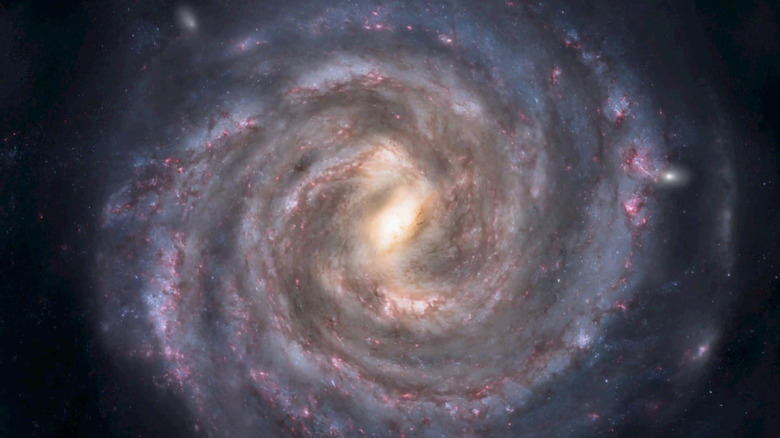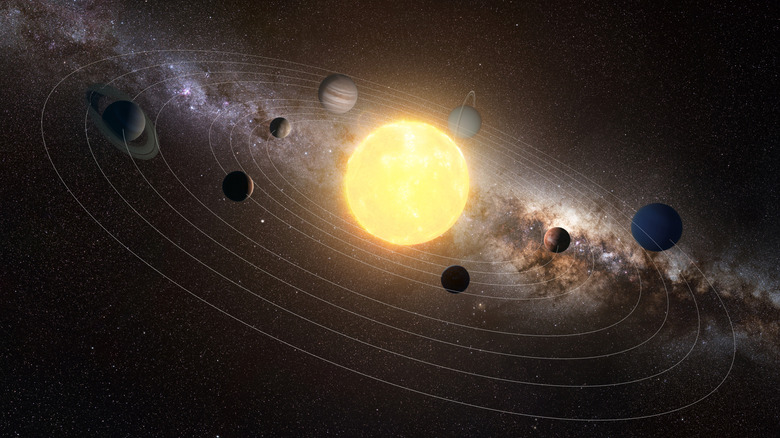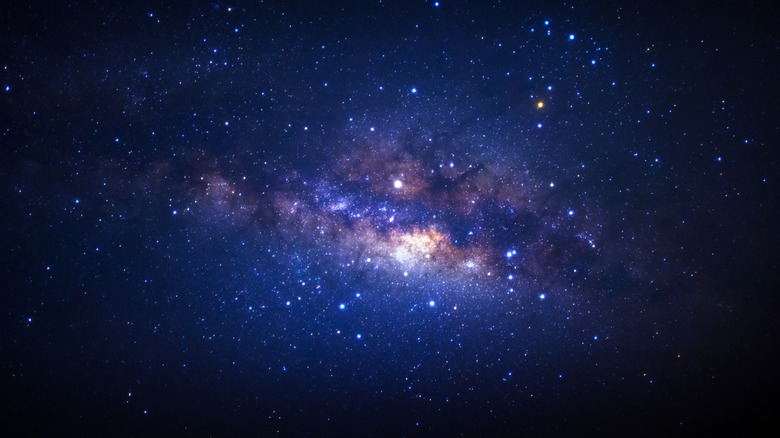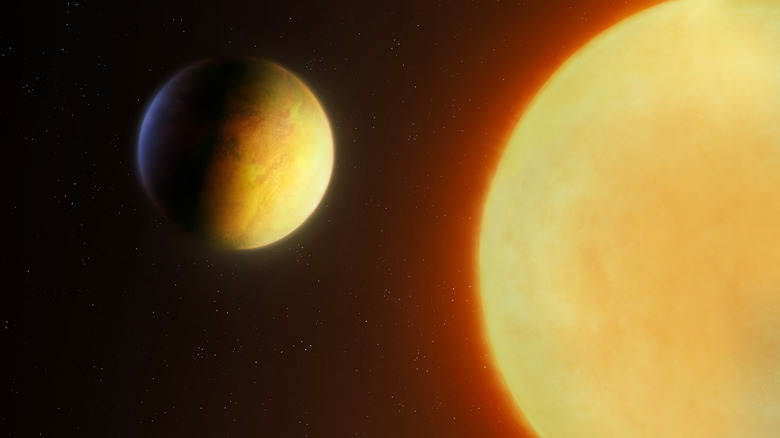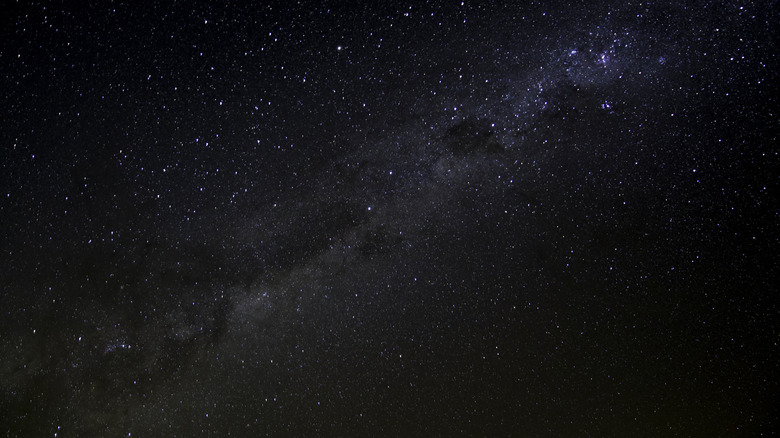Here's Why We Still Don't Know How Many Solar Systems Are In The Milky Way
We refer to our own solar system as the solar system, and in a sense, it is the only one of its kind. For centuries, our sun was known as Sol, latin for sun and the Roman equivalent of the Greek sun god Helios. As such, our star system, with its eight planets and five dwarf planets orbiting Sol at the center, is really the only SOLar system in existence. But in reality there is an unthinkable amount of similar star systems spread throughout the universe.
A star system refers to a collection of planets, meteors, or other objects which orbit a star or group of stars. Some of these include one central stellar object just like our own, but there have been as many as seven stars observed in a single system. Our own galaxy, the Milky Way, is thought to host between 100 and 400 billion stars, but there's no way to know the exact figure. Likewise, there's no way to know for sure how many star systems exist within our own galaxy.
But why? If we can identify the biggest known structure in the universe at 10 billion light years away (one light year equals 5.88 trillion miles), surely we can at least get close to determining the number of star systems in the Milky Way? As it turns out, it's not all that simple. In fact, up until 33 years ago, we didn't know of a single planet outside our own solar system, let alone a full star system of orbiting planets. As such, identifying such star systems is still very much a work in progress.
What we do know about star systems in the Milky Way
It's impossible to grasp the true scale of the universe and our miniscule place within it. Even trying to comprehend our own galaxy, which measures 100,000 light-years across, is difficult. The Milky Way might be relatively small compared to other galaxies, but it's still an immense collection of stars. Of course, stars mean star systems, and with between 100 and 400 billion stars in the Milky Way, there are a heck of a lot of star systems in our galaxy too. How many? While there is obviously an answer to this question, our own understanding of it is constantly evolving.
We do have a fairly solid understanding of the star system closest to ours. Alpha Centauri is about 4.2 light-years from our planet and is made up of three stars, Alpha Centauri A (Rigil Kentaurus), B (Toliman), and C (Proxima Centauri), making it a multi-star system unlike our own. This system includes two confirmed planets and three suspected planets, three of which orbit Alpha Centauri C while two orbit Alpha Centauri B.
Alpha Centauri isn't the only star system we've identified in this kind of detail, either. In 2023, scientists discovered a six-planet solar system 100 light years away in the constellation Coma Berenices. The result of a collaboration between NASA's TESS and the European Space Agency's Cheops missions, the discovery revealed a rare example of an in-sync system, meaning the planets all orbited the central star in synchrony with one another.
But while we're able to make such fascinating discoveries, it remains impossible to say for sure how many of these sorts of star systems actually exist within our galaxy, partly because of its sheer size.
The vastness of the Milky Way makes star system detection difficult
A major challenge facing scientists hoping to identify star systems in our galaxy is simply the size of the Milky Way itself. We know that the majority of the stars in our galaxy likely have planets in orbit around them, which would mean that the Milky Way is potentially home to billions of star systems. But currently only around 5,000 other stars with orbiting planets have been discovered and catalogued.
Of course, with our galaxy being as vast as it is, this is just a fraction of the total star systems that exist within the galaxy's boundaries. The Milky Way is full of countless cosmic objects aside from stars, including planets, meteors, and black holes. Mapping even small parts of such a colossal area with such a high density of objects is a mammoth task in and of itself, requiring an incredible amount of resources. As such, it will likely be some time before we have a solid understanding of just how many solar systems exist within our galaxy. But it's not just the size of the Milky Way that makes it difficult to identify these star systems.
Planets and planetary systems are extremely difficult to identify
Discovering stars is one piece of the detection puzzle, but detecting planets is the other. Aside from the size of the Milky Way and the sheer amount of stars within it, part of the problem with trying to determine how many star systems exist in our galaxy is that stars themselves are extremely bright, making it very difficult to spot planets and other objects in their orbit — especially since we're viewing these distant stars from light years away.
Our solar system exists in one of the Milky Way's smaller spiral arms — the Orion-Cygnus arm — which radiates out from the center of the galaxy. While we can use our vantage point to view certain elements of the surrounding galaxy, it becomes incredibly difficult to identify specific cosmic objects in star systems light years away, even while they exist within our own galaxy.
It wasn't until 1992 that astronomers Aleksander Wolszczan and Dale Frail used the Arecibo radio telescope — which later collapsed after being made famous by James Bond — to confirm the first exoplanets orbiting the pulsar PSR B1257+12, which sits 2,300 light years away from our planet. Three years later, the hunt for the very first planet orbiting a sun-like star was complete when in January 1995 graduate student Didier Queloz and his advisor, Michel Mayor, confirmed the existence of a planet transiting a star called 51 Pegasi. Since then, there have been multiple similarly exciting discoveries, but the technology which allows for such discoveries is still new, meaning our search for exoplanets and their star systems is really only just getting started.
NASA has made progress identifying planets and star systems in the Milky Way
We might not yet have an exact figure for how many star systems exist in the Milky Way, but we've made some significant progress since the first exoplanet was discovered. NASA's Kepler space telescope, for example, has allowed us to identify several planets in other star systems. Launched on March 6, 2009, the telescope was used to search a section of the Milky Way for Earth-sized planets orbiting other stars. In August of the following year, NASA researchers published results of the mission, which showed that Kepler had discovered the very first star system with multiple planets orbiting the same star, Kepler-9.
Over the next nine years, results from the Kepler mission showed that the Milky Way is home to billions of exoplanets, meaning there are more planets in our galaxy than stars.Thus far, NASA has identified and named over 7,400 of these exoplanets, alongside over 5,000 planetary systems, and the agency is now tracking a rare planet unlike anything in our solar system. But this is barely a fraction of the billions of planets and planetary systems out there. As such, even with Kepler's hugely successful nine years in deep space, we're still not close to a reliable number when it comes to accounting for all the star systems existing within the Milky Way.
Essentially, then, the amount of known star systems in the Milky Way is constantly changing as we discover and observe new areas of our galaxy. All the while, the total number of solar systems in the Milky Way remains elusive — at least, for now.
